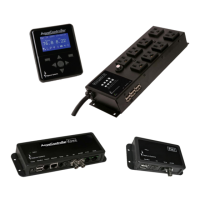Apex Classic Setup and Programming Guide v2.2 Page 53
In this example, the state of the pH command is overruled by the state of Light1
and they all are overruled by Switch1 commands. Whenever Switch1 is closed,
the outlet is on and whenever it is open, the outlet is off, the first 2 commands
are essentially ignored. However, simply reordering the commands yields a
totally different program:
If Switch1 CLOSED Then ON
If Switch1 OPEN Then OFF
If Outlet Light1 = ON Then OFF
If pH > 8.50 Then OFF
The same commands in this order allow the state of Light1 and pH to override
the state of the Switch1.
When considering order of operation, keep the following in mind:
1. Program commands are executed (processed) in the order they are listed in
the Advanced Program list. As commands are executed, the AquaController
Apex keeps track of the “internal” state of the outlet but does not actually
switch the outlet. The last true program statement is used to set the outlet
state.
2. Once all the commands for an outlet are executed, if the internal state of
the outlet is different than the actual outlet state, a control command is
sent to the outlet and the actual outlet state is switched.
3. Steps 1 & 2 are continuously executed as fast as possible for all outlets
configured on the AquaController Apex system. Depending on the number
of outlets and program complexity, all outlet programs are usually executed
1 to 2 times per second.
REPEAT INTERVAL
As described in the previous section titled Order of Operation, the internal state
of the outlet is not sent to switch the actual outlet each and every time the outlet
program is executed, it only sends the outlet update commands when the state
of the outlet has changed. In the remote possibility that an outlet misses a
command for some reason, the outlet may get out of sync with the state the
Apex Base Module. To remedy this condition, the AquaController Apex is
programmed to repeat the state of all outlets on a periodic basis. The period
between these updates is called the Repeat Interval.

